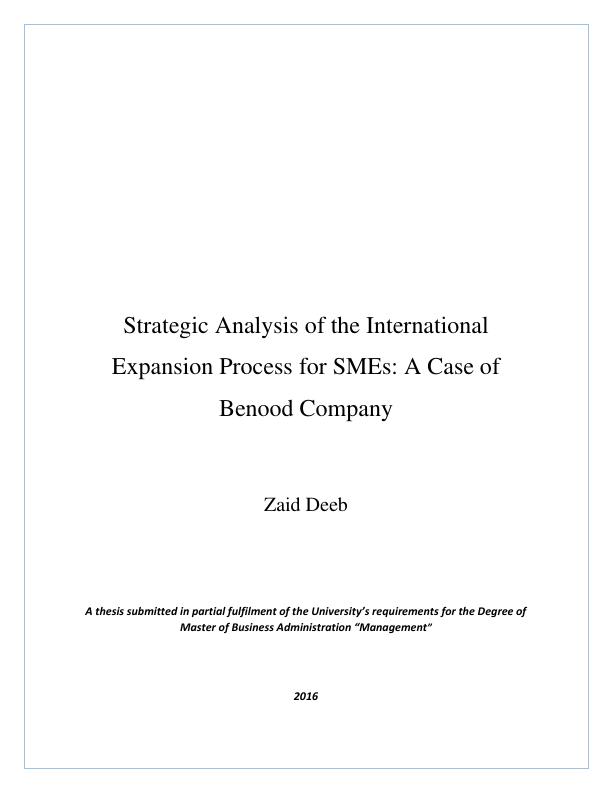By taking an oil field supply and services company named Benood as a case, the purpose of this research is to strategically analyse the company’s expansion process by analysing the internal and external environmental factors, as well as evaluating and reviewing the possible modes of entry and the strategic consequences within three different locations which are: UAE, China and Nigeria.
Apart from the high costs attributed to the expansion process, when it comes to SMEs, their characteristics can pose additional challenges related to expanding. The limited financial resources and the managerial structure of SMEs can make them more vulnerable to environmental factors than large MNEs.
The literature review oriented the theoretical contribution by reviewing the applied frameworks, which aims to identify the major environmental factors that would affect the firm within each location. PESTEL analysis was applied to evaluate the macro external environment. On the other hand, Porter’s five forces, industry lifecycle and strategic group analysis were applied to evaluate the external micro environment which represents the competitive situation in each country.
Accordingly, value chain analysis and Hofstede’s cultural dimensions are the applied tools to analyse the major internal environment of the firm. Moreover, SWOT analysis summarised the major external and internal factors within each country in order to assess the evaluation of entry modes and strategic option.
Consequently, based on secondary data from governmental and trusted agencies, the findings of this research revealed that each location could offer lucrative opportunities to exploit, given that the industry represents a substantial percentage of the imports and exports within the three countries. At the same time, the firm could face several challenges in each location. For instance, the recent drop in oil prices could affect the value chain significantly.
Inhaltsverzeichnis (Table of Contents)
- CHAPTER ONE: INTRODUCTION.
- GENERAL OVERVIEW:
- BENOOD'S BACKGROUND:
- IRAQ'S BACKGROUND:
- PROBLEM ORIENTATION:
- RESEARCH QUESTIONS:
- AIMS AND OBJECTIVES:
- SUMMARY:
- CHAPTER TWO: LITERATURE REVIEW
- EXTERNAL ENVIRONMENT FRAMEWORKS:
- PESTEL Framework:
- Porter's Five Forces Industry Analysis:
- Industry Life Cycle:
- Strategic Group Analysis:
- INTERNAL ENVIRONMENT FRAMEWORK:
- Value Chain Analysis:
- Hofstede's Cultural Dimensions:
- SWOT Analysis:
- MODES OF MARKET ENTRY:
- ANSOFF'S MATRIX:
- SUMMARY:
- CHAPTER THREE: RESEARCH METHOD.
- RESEARCH PERSPECTIVE:
- RESEARCH DESIGN:
- RESEARCH STRATEGY:
- DATA COLLECTION:
- STUDY LIMITATIONS:
- RELIABILITY VALIDITY AND GENERALISABILITY:
- ETHICAL CONSIDERATIONS:
- CHAPTER FOUR: DATA COLLECTION, ANALYSIS, AND FINDINGS..
- EXTERNAL ENVIRONMENT ANALYSIS:
- PESTEL Analysis:....
- Porter's Five Forces:
- Industry Life Cycle
- Strategic Group Analysis:
- INTERNAL ENVIRONMENT ANALYSIS:
- Value Chain Analysis:...
- Hofstede's Cultural Dimensions:
- SWOT Analysis:
- ENTRY MODES ANALYSIS:
- STRATEGIC REVIEW:
- CHAPTER FIVE: CONCLUSION AND RECOMMENDATIONS
- CONCLUSION:
- RECOMMENDATIONS:
Zielsetzung und Themenschwerpunkte (Objectives and Key Themes)
This thesis aims to analyze the international expansion process for small and medium-sized enterprises (SMEs), specifically focusing on the case of Benood Company. The study employs a range of frameworks and methodologies to examine the company's potential for international growth, considering both external and internal environmental factors.
- External Environmental Analysis
- Internal Environmental Analysis
- Modes of Market Entry
- Strategic Review and Recommendations
- Case Study: Benood Company
Zusammenfassung der Kapitel (Chapter Summaries)
Chapter One: Introduction provides an overview of the study's context, including Benood Company's background and the broader economic environment in Iraq. It also outlines the research questions, aims, and objectives.
Chapter Two: Literature Review explores relevant theoretical frameworks for analyzing international expansion. This chapter examines external environment frameworks such as PESTEL, Porter's Five Forces, Industry Life Cycle, and Strategic Group Analysis. It also covers internal environment frameworks like Value Chain Analysis, Hofstede's Cultural Dimensions, and SWOT Analysis. Finally, the chapter discusses different modes of market entry and Ansoff's Matrix.
Chapter Three: Research Method details the research design, strategy, and data collection methods employed in the study. It also addresses study limitations, reliability, validity, generalizability, and ethical considerations.
Chapter Four: Data Collection, Analysis, and Findings presents the results of the research. This chapter analyzes the external and internal environments using the frameworks discussed in Chapter Two. It also examines the potential modes of entry for Benood Company and explores the company's strategic options.
Schlüsselwörter (Keywords)
This thesis focuses on strategic analysis, international expansion, SMEs, case study, external environment, internal environment, PESTEL, Porter's Five Forces, Industry Life Cycle, Strategic Group Analysis, Value Chain Analysis, Hofstede's Cultural Dimensions, SWOT Analysis, Modes of Market Entry, Ansoff's Matrix, Benood Company, Iraq.
- Quote paper
- Zaid Deeb (Author), 2016, International expansion process for SMEs. A strategic analysis of the oil field supply and services company "Benood", Munich, GRIN Verlag, https://www.grin.com/document/318251




